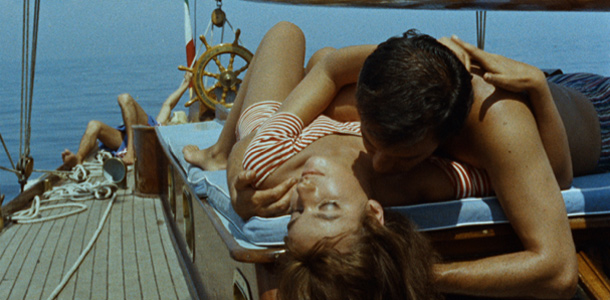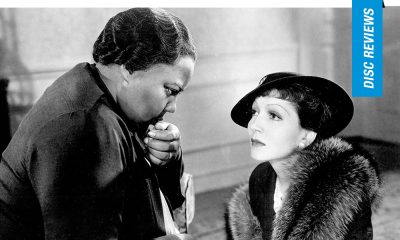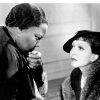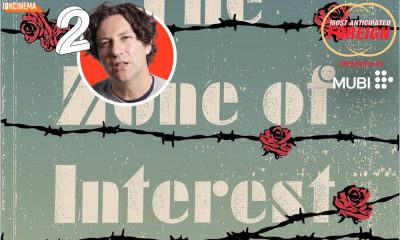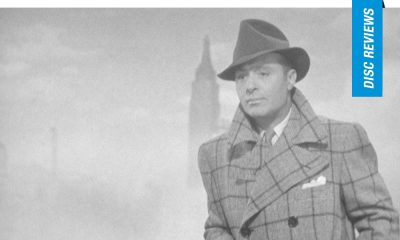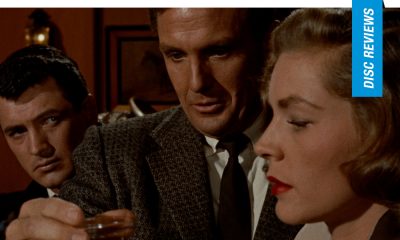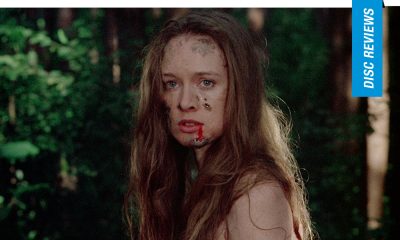Disc Reviews
Criterion Collection: Purple Noon | Blu-ray Review
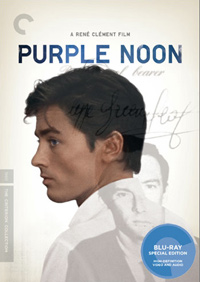 Remade forty years later as The Talented Mr. Ripley, René Clément’s Purple Noon from 1960 was the first attempt to bring amorphic rogue Tom Ripley, the subject of a series of popular crime novels by Patricia Highsmith, to the screen. Ripley was a precursor of today’s identity thieves, but instead of huddled in front of lonely computer, Ripley went to popular jet set locales and hobnobbed with the idle rich, getting to know every detail about the lives of his potential victims. Once Ripley had assumed their identities, no measure was too extreme to protect his secret or prevent his unmasking.
Remade forty years later as The Talented Mr. Ripley, René Clément’s Purple Noon from 1960 was the first attempt to bring amorphic rogue Tom Ripley, the subject of a series of popular crime novels by Patricia Highsmith, to the screen. Ripley was a precursor of today’s identity thieves, but instead of huddled in front of lonely computer, Ripley went to popular jet set locales and hobnobbed with the idle rich, getting to know every detail about the lives of his potential victims. Once Ripley had assumed their identities, no measure was too extreme to protect his secret or prevent his unmasking.
Now available in a spectacular Criterion blu-ray, Purple Noon features the then relatively unknown but equally spectacular Alain Delon as the crafty con artist. The film is set largely on the Italian coast, but frankly, the sensual, deep azure of the Mediterranean Sea has a hard time competing with Delon’s beauty. Ripley has been sent to this sun drenched paradise in search of a pampered playboy named Philippe (Maurice Ronet), whose profligacy his wealthy father is weary of bankrolling and wants back home in San Francisco. However, Ripley and Philippe become friends, in a frat boy, hail fellow well met sort of way, and along with Philippe’s long suffering girlfriend Marge (Marie Laforêt), the trio spend their days in leisure aboard a sailboat amid vistas of scenic splendor.
As Purple Noon is a highly structured, plot driven thriller, little more can be offered in the way of plot synopsis, but suffice to say that narrative twists and turns eventually place Ripley at the epicenter of a complex web of fraud, and much worse. However, Purple Noon’s true significance lies in the artistry and aesthetics of its execution. Clément tells the story with the elegant competence of a true veteran, managing Highsmith’s knotty mosaic with clarity and conviction, often in circumstances less than ideal. If one has ever tried to stage and film coherent action sequences from the narrow, slippery deck of a fast moving sailboat, the full measure of Clément’s skill becomes apparent.
But Purple Noon is not all sturm und drang, as Clément on occasion allows his camera to luxuriate over documentary scenes of everyday Italian life. These unvarnished moments provide some of the film’s richest pleasures, as the impossibly handsome Delon mixes with the craggy rustics at a bountiful village market. A sequence filmed in an outdoor Roman trattoria proves conclusively that there is no elegant method of eating spaghetti, even among the experienced native populace. Speaking of eating, here Clément was not entirely adverse to visual metaphors, as Ripley often engages in a savage style of face-stuffing after his most loathsome criminal acts.
Purple Noon also stands as a testament to the talent of Henri Decaë, the prolific cinematographer who transitioned seamlessly from b/w to color (and back) numerous times over his lengthy career. Hollywood cinematographers had a tendency to over-light in the early days of single strip color stock, retaining the harsh, melodramatic schemes they’d learned in film noir. In American color films of 1950s and early ‘60s. it’s not unusual for each actor to cast three shadows, creating what filmmakers today jokingly call “The Universal Studios Look.” Decaë rejected such artifice, and championed a softer, more natural look for color through the perfect manipulation of fill. The breadth of Decaë’s filmography — everything from wartime documentaries to la nouvelle vague to big budget Hollywood hits — made him a walking lexicon of visual styles and techniques.
Disc Review
The 1.66:1 high-def transfer is a stunner, with deep ocean blues and dusty village ochres presented with seductive vividness and clarity. Delon’s powder blue eyes, the chief weapon in his acting arsenal, seem to project magical sparks in close-ups. Blacks are true with excellent detail and remain uncontaminated by neighboring hues. The disc’s cleanliness is equally impressive, giving this fifty year old negative a pristine glow. I have had the pleasure of reviewing a number of Criterion blu-rays in recent years, and visually none have surpassed Purple Noon. The mono audio track has been restored to an equal level of polish, and is free from distractions with all sonic elements crisp and well balanced.
New interview with René Clément scholar and author Denitza Bantcheva
In a 25 minute segment, Bantisheva delivers an impressive knowledge of the making of Purple Noon, along with biographical information on the creative principals. Of particular interest is her recounting of the long running feud between Clément and Truffaut, a story that doesn’t show the latter in a very good light. In all, this supplement will be of interest mainly to fans of French cinema and its history.
Archival interviews with actor Alain Delon and novelist Patricia Highsmith, on whose book The Talented Mr. Ripley the film is based
Delon’s interview, filmed for French television in 1962, goes into great detail on his early years and his serendipitous beginning in the acting profession. He expresses great admiration for directors and credits Clément with teaching him the most about the actor’s craft. The nine minute piece is must viewing for fans of Delon.
Highsmith’s piece, also made for French TV in 1971, is more of documentary portrait, and features scenes of her everyday life. She discusses the writing process and her preference for solitude. Highsmith expounds on her childhood in Texas and her spiritual affinity for the shady side of the Tom Ripley character. Highsmith comes off as surprisingly sympathetic in the interview considering in later years she would become notorious for her bigotry and anti-semitism. The segment is a fascinating 20 minutes.
Original English-language trailer
This breezy four minute assembly often feels more like a travelogue than a teaser. In North America, the film was released under the title The Talented Mr, Ripley.
PLUS: A booklet featuring an essay by film critic Geoffrey O’Brien and excerpts from a 1981 interview with Clément
A handsome 34 page booklet accompanies the release featuring numerous full color film stills and production credits. O’Brien’s essay In Broad Sunlight, mines the depths of the Ripley character and his self discovery through impersonating others, along with copious behind the scenes information. The Clément interview touches on all aspects of Purple Noon’s creation, from initial meetings to editing and music composition.
Final Thoughts
While hardly a great film, Purple Moon remains a well executed entertainment with subtle overtones of Hitchcock, and should please fans of classic thrillers. For those more interested in art house fare, the film represents a cinema in transition from clear cut moral absolutes and toward an embrace of the all-too-human anti-hero. Tom Ripley’s motivations and methods may not reflect the better angels of our nature, but deep down viewers will find themselves ultimately wishing for his success. And as embodied by Alain Delon, René Clément’s lovable scoundrel helped blaze a trail for the countless heroic outlaws who would dominate movie screens later in the decade.



